In April, Mongabay’s Ashoka Mukpo visited the Sherbro estuary, a sprawling riverine ecosystem of mangroves and coastal fishing villages on the Sierra Leonean coastline.Like other coastal areas in West Africa, the Sherbro estuary is already suffering the impacts of climate change, including flooding and higher temperatures.Between 2016 and 2021, USAID financed mangrove replanting and the construction of makeshift seawalls in villages here as part of a coastal climate resilience aid project.The project’s struggles here are an example of the difficulties that climate aid efforts can face when they meet the economic and social needs of people in vulnerable areas.
BONTHE, Sierra Leone — As the sun rises over Bonthe, a small city on the coastline of Sierra Leone’s remote Sherbro Island, echoes of a not-so-distant colonial past bathe in the red glow of early morning. A crumbling stone warehouse, its façade scarred by years of salt and humidity, stands in front of a vast, mangrove-laden riverine estuary. Above its doorway, faded lettering reads “Patterson, Zochonis” — two European traders who made their fortunes in what was once called British West Africa.
Nearby, a worn white and gray church bearing the name Amistad watches over a quiet road. Sengbe Pieh, leader of the famous slave rebellion on the ship that the church was named for, was born on the island, and legend says his gravesite is hidden somewhere in the forest here.
Bonthe, and the Sherbro estuary in general, was once a major trading outpost for the British Empire, feeding what was then an emergent global economy with slave labor and, later, tropical commodities like palm oil. Now it’s a sleepy fishing town of about 10,000 people. Even reaching Bonthe is no small feat — the journey from Sierra Leone’s capital, Freetown, involves a series of public buses, motorcycle rides down dirt highways, and a wooden public boat that ambles across the sprawling estuary, shuttling goods and travelers between the tiny fishing villages that dot its coastline.
The city of Bonthe, Sierra Leone. Photo by Ashoka Mukpo for Mongabay.
As the morning light shines on brightly painted fishing boats that bob near Bonthe’s main pier, it also brings into view a newer, more ominous structure. Snaking along the coastline in front of the town is a stout mound made of concrete and rocks. It’s a seawall, built a few years ago to combat the flooding that’s become common during the rainy season here. Like many other coastal towns in West Africa, the ocean is eating into Bonthe.
At this year’s COP27 U.N. climate conference in Egypt, the question of what the rich world owes countries like Sierra Leone consumed the proceedings, leading to a tentative agreement — albeit a vague one — on the establishment of a “loss and damage” fund to compensate vulnerable nations for climate-related disasters. In places like Bonthe, the loss and damage debate isn’t an abstraction. Homes are already being lost to the sea, and more upheaval may be around the corner. How much aid people in places like this will need to cope with a changing environment — and what form that aid should take — is a bitterly contested question. But it’s one with high stakes for people living in the face of floods, extreme heat, and, as here in Bonthe, an advancing ocean.
Dollar figures tend to dominate the international debate over climate finance, but Bonthe’s recent history suggests the amount of money spent on aid projects only tells part of the story. Between 2015 and 2021, the Sherbro estuary was a major focus of USAID’s flagship environmental aid project in West Africa. As part of that project, USAID and its contractors financed the planting of mangrove trees meant to combat flooding, and helped construct makeshift seawalls in some of the estuary’s small fishing villages. But just a few years after the project closed down, in the villages visited by Mongabay the aid agency’s efforts were struggling under local economic pressures or had already been mostly reversed.
With an increasingly loud global chorus calling for countries like the U.S. to spend more on helping Sierra Leone and its counterparts deal with climate change, Bonthe has a message for the world: the “how” of climate finance is just as important as the “how much.”
A bad tide rising
According to USAID, just over 200,000 people live in the 283-square-kilometer (109-square-mile) Sherbro estuary. From the air, the estuary’s coastline is magnificent, a sea of radiant green mangrove forests pockmarked with tiny villages along the edges of its churning saltwater channels. Inside those villages, people make their living fishing, harvesting oysters from nearby mangrove roots, and selling wood from their trunks for cooking and smoke-drying fish.
As in other parts of Sierra Leone, lately the weather has begun to change in Sherbro. The dry season is hotter than it was before, and the rains are arriving earlier, with more unpredictable and occasionally devastating force. At the height of the rainy season, when the estuary’s water levels are high, the ocean floods into some of the towns during storms, destroying houses and washing away people’s belongings.
“In the coastal areas there has been an increase in the sea level,” said Gabriel Kpaka, deputy director-general of the Sierra Leone Meteorological Agency and one of the country’s chief climate negotiators. “Most of these areas don’t have a seawall or a dike, so in high tide water comes into them and flooding is now common.”
In Bonthe, when the flooding started damaging homes and businesses a few years ago, the local government raised funds to build the concrete seawall that now lines its main beach. Locals say the wall is helping, and has bought them some time. But the smaller towns farther up the coastline don’t have the resources that the comparatively wealthy city does. People who live in them can’t afford to build sturdy concrete walls, and in the last few years it’s become common here for some towns to be severely damaged during recurring floods.
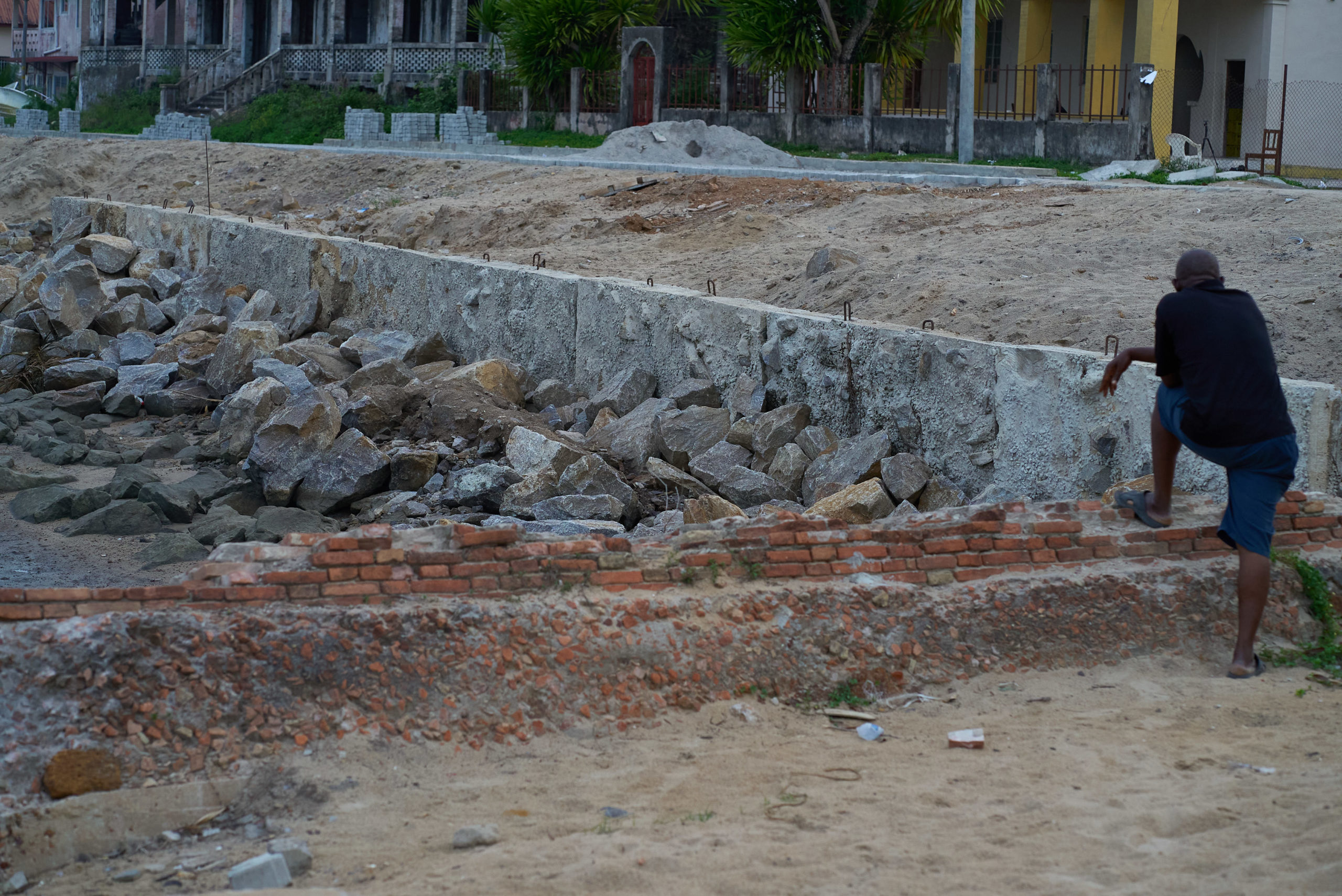 A section of Bonthe’s newly constructed sea wall. Photo by Ashoka Mukpo for Mongabay.
A section of Bonthe’s newly constructed sea wall. Photo by Ashoka Mukpo for Mongabay.
“In [the town of] Nyangai, with this climate change, the water level rose. Houses that were built along the beach, everything was carried away. Even the coconut trees that were planted were carted away by the sea,” said Daniel Bangali, a program officer with Coastal Environmental Watch, a small environmental organization based in Bonthe.
Nyangai’s story is worryingly familiar for people here in the estuary. In Hanging Site, named for the British vessels that used to drop their anchors nearby, Miatta Moyu points to the edge of the town where a few small sand-and-concrete houses stand perilously close to the lapping waves.
“Some houses there all broke,” she said. “They tried to build a seawall, but it didn’t work. The water still came.”
In 2018, USAID published a climate change vulnerability assessment for regions like this in Sierra Leone. As part of the assessment, researchers surveyed people living near mangrove forests, including here on Sherbro Island. Vast majorities said that incidents of high temperatures, rainfall and storms had become more severe in recent years.
According to its 2021 National Adaptation Plan, Sierra Leone still doesn’t have a marine meteorological station it could use to accurately measure how much sea levels have risen in the past decade. But the plan cited World Bank estimates that say nearly 30 km2 (11.5 mi2) of Sierra Leone’s coastline could be lost to the sea by 2050, a catastrophe that would cost the impoverished nation upwards of $50 million. Sierra Leone isn’t alone in facing this threat. Across the West African coastline, entire towns are being swallowed by the ocean.
“When I joined the [Meteorological] Agency 12 years ago, there used to be flooding like every three years, but recently almost every year flooding is happening,” Kpaka said.
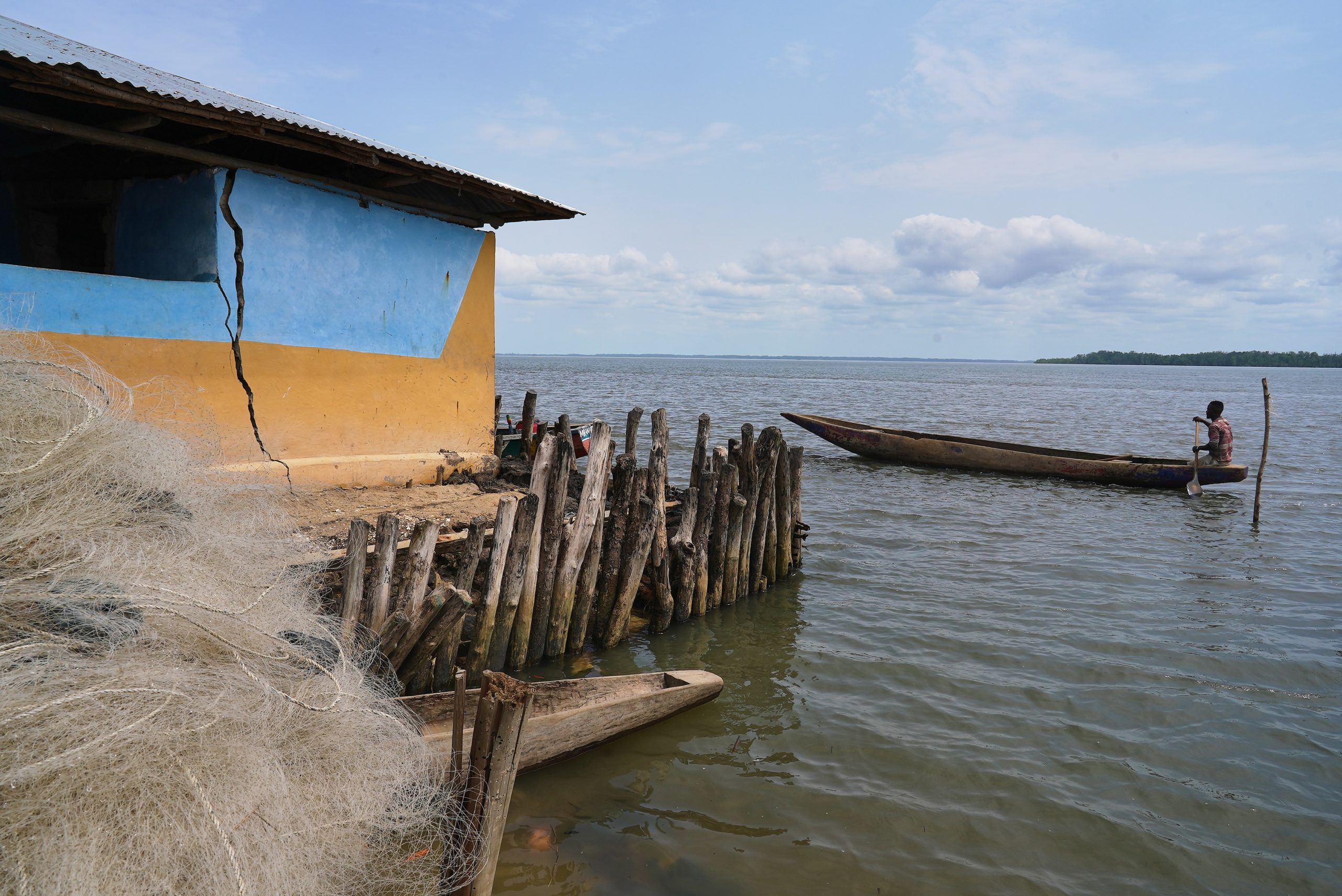 A makeshift seawall built with mangrove wood in the Sherbro estuary. Photo by Ashoka Mukpo for Mongabay.
A makeshift seawall built with mangrove wood in the Sherbro estuary. Photo by Ashoka Mukpo for Mongabay.
Largely cut off from Sierra Leone’s centers of economic activity, the Sherbro estuary is cash-poor, with few social services or opportunities for non-subsistence work. There is no electrical grid, and water is largely obtained from rivers, creeks or, if a town is lucky, a borehole well.
But while climate change is a problem for people here, most have more urgent concerns. Money and education topped the list of “worries and stressors” for people surveyed by USAID, far outpacing the threat of flooding and other climate risks. Overall, environmental issues barely registered higher than mosquitoes and marital problems in the survey.
The stress of basic day-to-day needs in Sherbro helps explain why one of the best protections against climate change for people here — the mangroves surrounding their towns — are in trouble. Mangrove wood is a crucial component of how the estuary’s residents make money. It’s used to cook food, preserve fish, and build homes. When the trees are cut down too close to the towns, though, the topsoil is eroded, which can worsen their problems with flooding.
This, along with the rich biodiversity of the mangrove forests and their role in mitigating climate change — acre for acre, mangroves sequester five times as much carbon as other tropical forests — is partly why USAID chose the Sherbro estuary to work in. The aid agency’s struggles here are a snapshot of the difficulties that climate aid can face when it reaches the ground.
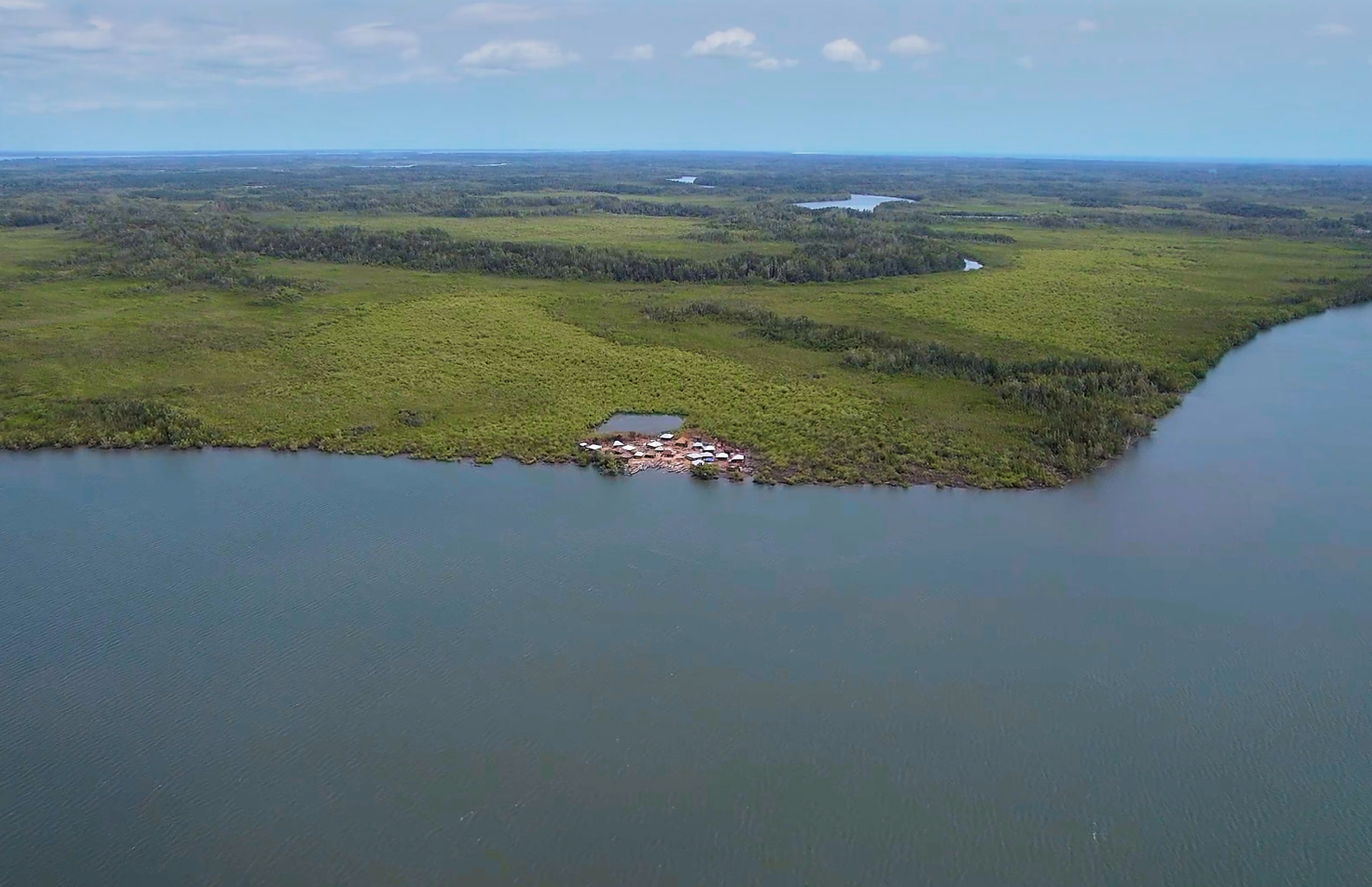 The town of Jayahun in the Sherbro estuary. Photo by Ashoka Mukpo for Mongabay.
The town of Jayahun in the Sherbro estuary. Photo by Ashoka Mukpo for Mongabay.
If a mangrove falls in the forest
Traveling through its choppy inlets by speedboat, the mangrove forests of the Sherbro estuary present themselves as endless. They stretch for miles in all directions, with their knotted roots, called “elbows,” poking out of muddy embankments that rise out of the shoreline as far as the eye can see. A 2020 assessment estimated that, overall, Sierra Leone’s mangrove forests total 1,575 km2 (608 mi2), around half of which are in the Sherbro estuary.
The mangroves in Sherbro are Rhizophora racemosa, also known as red mangroves. They provide a home to a wide array of wildlife, including leatherback sea turtles (Dermochelys coriacea), West African manatees (Trichechus senegalensis), dwarf crocodiles (Osteolaemus tetraspis), Campbell’s monkeys (Cercopithecus campbelli) and 107 species of birds. African fish eagles (Haliaeetus vocifer) and other raptors prowl the skies, circling majestically over the maze-like canals that snake through the estuary.
But like in most parts of Sierra Leone, Sherbro’s mangroves are being lost. According to Sierra Leone’s National Adaptation Plan, about a quarter of the country’s mangrove forests have disappeared since 1990. In the remote Sherbro estuary, it hasn’t been quite so catastrophic — just under 10% of its mangroves have been destroyed during that period — but with a growing population it’s virtually certain that deforestation here will increase.
Most of this destruction is a product of necessity. Sherbro’s residents rely heavily on the mangroves. They provide shelter from wind and sun, and the fish and oysters that fill their dinner bowls breed in the brackish water that flows through their roots. But mangrove wood is also used to build houses and smoke-dry fish, the sale of which is a major source of income for people in Sherbro. The mangroves are a major — and, at least for now, irreplaceable — piece of people’s livelihoods. Along the coast and on the outskirts of Sherbro’s villages, the results of this pressure are visible in the form of sun-bleached clearings full of dead branches where mangrove wood was recently cut.
 A patch of recently deforested mangroves in the Sherbro estuary. Photo by Ashoka Mukpo for Mongabay.
A patch of recently deforested mangroves in the Sherbro estuary. Photo by Ashoka Mukpo for Mongabay.
These clearings are also symbolic of the bind people in Sherbro are in, and its environmental cost. Without the relative safety of the tangled roots, and compounded by illegal overfishing by foreign trawlers, mangrove deforestation is causing a drop in fish and oyster populations. When wood is gathered too close to the villages, it also weakens a natural barrier against the impacts of climate change.
“Because they cut the mangroves in front of their communities, the sea level rise is eating into their [towns], and the breeze from the sea is disturbing them,” said Tom Menjor, a former monitoring and evaluation officer with USAID who helped manage the aid agency’s programming in Sherbro.
Sierra Leone’s mangrove forests were a centerpiece of one of USAID’s major environmental aid projects in recent years, the West Africa Biodiversity and Climate Change (WABiCC) program, a $48.9 million initiative that ran from 2015 to 2021. WABiCC was a sprawling aid package that also funded forest protection in Guinea and Liberia, efforts to combat wildlife trafficking, and climate-related support for people living in Cote D’Ivoire’s mangrove regions as well.
During the time it was in Sherbro, WABiCC ran training workshops in villages on the consequences of cutting down the mangroves. Tribal authorities received stipends to attend meetings where they discussed conservation plans, and in some towns USAID funded a multiyear effort to replant some of the destroyed mangroves and build makeshift seawalls with sandbags and oyster shells.
But just a few years after the close of the project, in many of those towns there isn’t much left of USAID’s six years of work. According to Daniel Bangali, who was a municipal leader in Bonthe during WABiCC’s activities, very few of the planted mangroves survived, and without funding for their maintenance, most of the sea barriers were mostly destroyed by sun and saltwater.
“Before WABiCC left, there was a small impact,” Bangali said. “But [after they left] in other communities, it was a total failure.”
During an interview in Bonthe, Bangali told Mongabay that USAID’s project was good at broadcasting information to people about the role the mangroves played in protecting them from climate change, but it didn’t provide a way to shift to alternative fuel sources or less destructive methods of preserving fish. Thus, when the project ended, most of its activities simply faded away.
“If it had continued, maybe there would have been a reduction [in mangrove cutting],” Bangali said. “But when they left there was no other organization to continue [the work].”
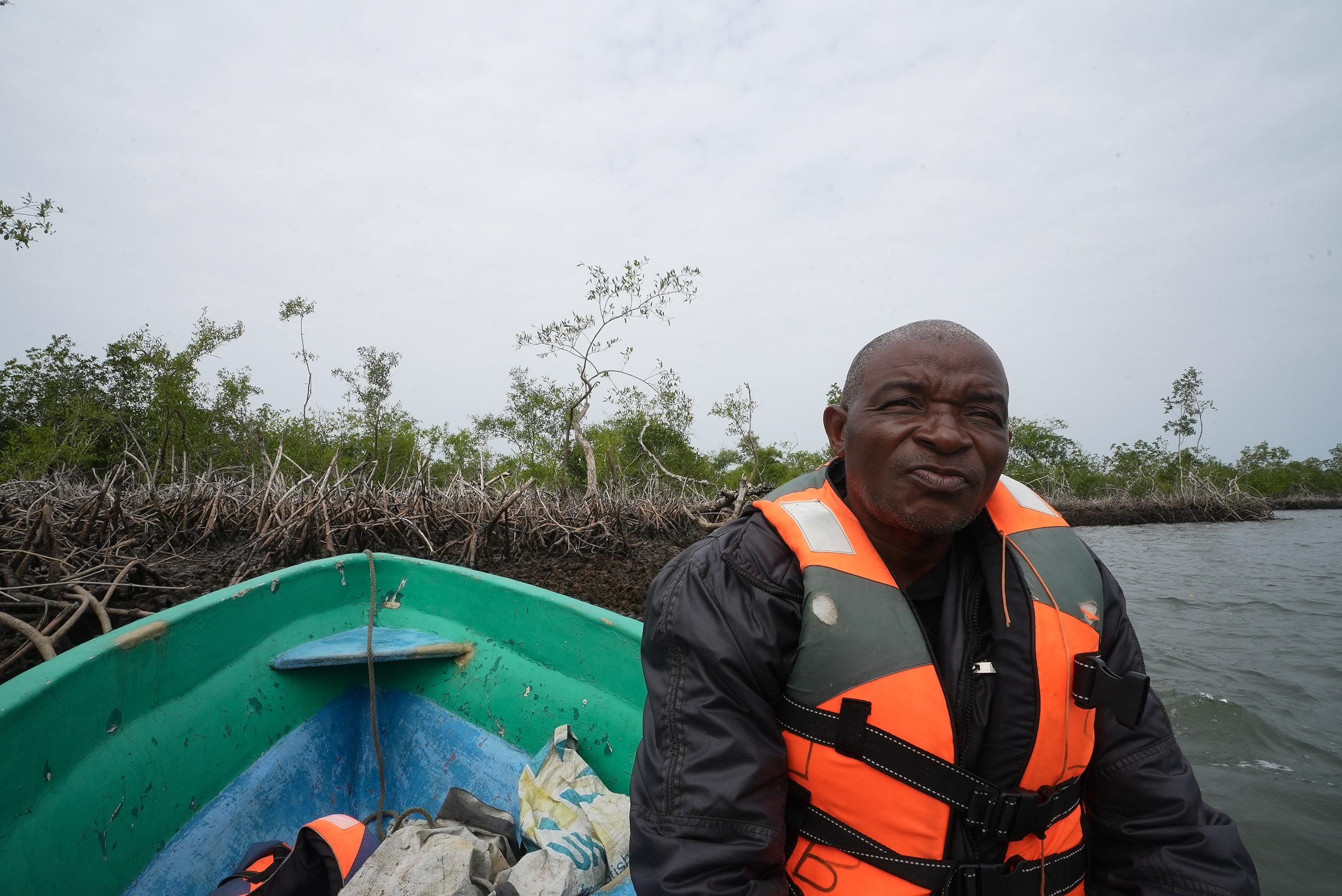 Daniel Bangali of Coastal Environmental Watch near a patch of deforested mangroves. Photo by Ashoka Mukpo for Mongabay.
Daniel Bangali of Coastal Environmental Watch near a patch of deforested mangroves. Photo by Ashoka Mukpo for Mongabay.
According to WABiCC’s final report, as part of its climate-related activities, 25 communities in the Sherbro estuary were selected to take part in the mangrove replanting effort. Fifty-five thousand mangrove seedlings in total were planted in the Sherbro estuary.
But in the communities visited by Mongabay, most of the replanted mangroves had either died or been eaten by livestock. In Bonthe, they were simply buried when local authorities decided to use the planting sites for other forms of municipal development. Bangali said people participated in the planting efforts because they were paid a daily wage, but many of the seedlings died not long afterwards.
“When there was communal work, and [USAID] called them, they would do it. But then what happened? The people left, so [the community] reverted back to cutting mangroves,” he said.
In Hanging Site, a 30-minute boat ride up the coast from Bonthe, Miatta Moyu squints at a swampy area next to the town, gesturing toward a small patch of juvenile mangroves in the center. They’re all that’s left now of the USAID-financed planting effort. Out of 1,000 mangrove seedlings, she estimates only about 60 survived. The rest were eaten by livestock.
“People didn’t stop [cutting the mangroves],” she said. “Because it’s how we’re living, we sell the wood to cook fish, so we can’t stop. It’s not easy.”
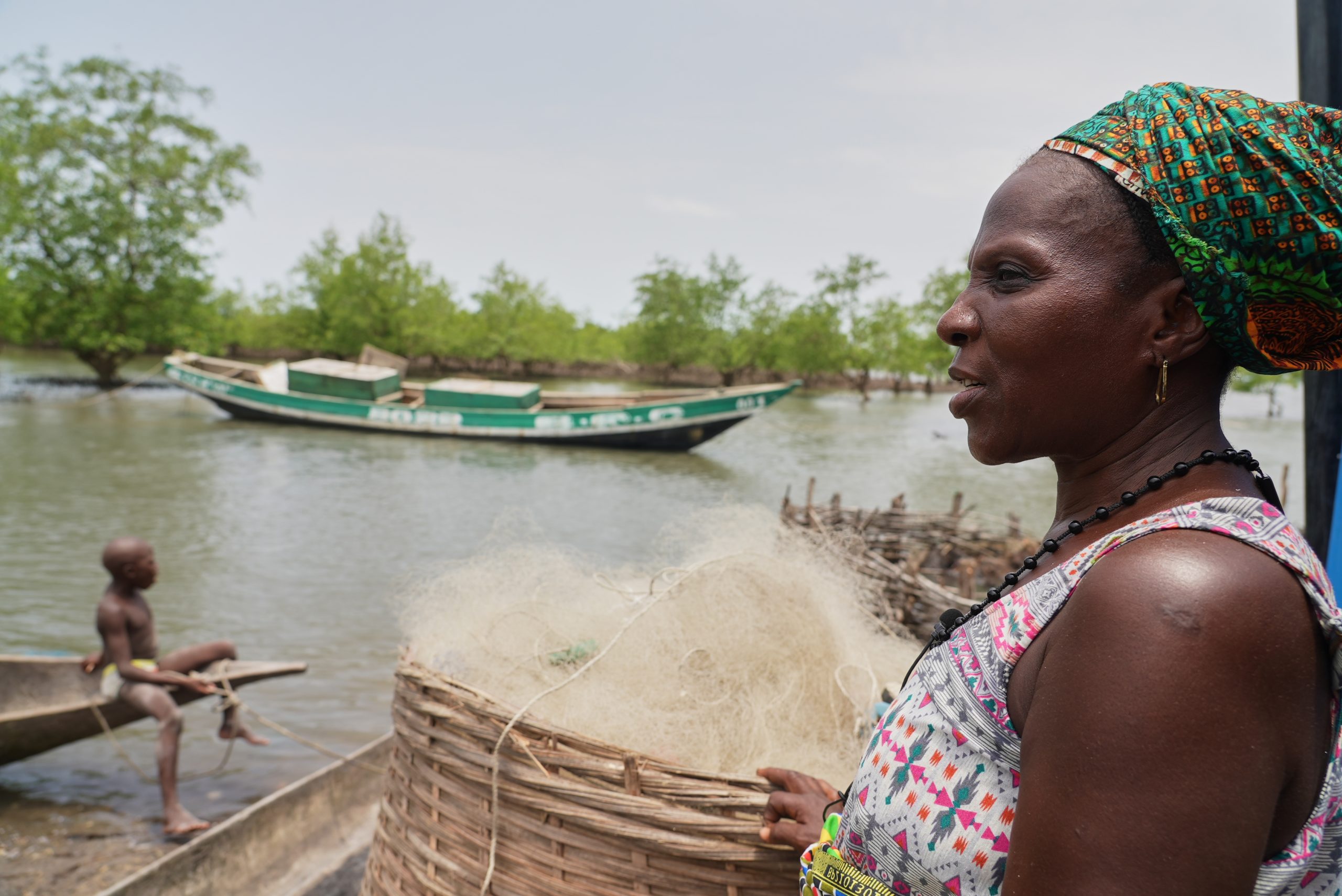 Miatta Moyu stands near an area where mangroves were planted with USAID support in Hanging Site. Photo by Ashoka Mukpo for Mongabay.
Miatta Moyu stands near an area where mangroves were planted with USAID support in Hanging Site. Photo by Ashoka Mukpo for Mongabay.
A mid-term performance evaluation for WABiCC acknowledged the shortcomings of the project’s mangrove replanting efforts, saying that without tackling the underlying economic pressures that were forcing people to cut the trees down, planting new ones was “counterproductive and unsustainable.” Former staffers with the USAID project told Mongabay they heard much the same from people living in the towns they had worked in.
“It’s really complicated, but their focus was, ‘You can’t tell us not to cut mangroves if you don’t provide us an alternative,’” said Menjor, the former WABiCC monitoring officer who now works for a water company in Freetown.
Menjor, who visited Sherbro on multiple occasions, said the project often ran into complex and unforeseen realities on the ground. Manatees were attracted to mangrove barriers planted near rice paddies, for example, which were then destroyed by the hungry animals. In other cases people couldn’t afford to maintain the sea barriers that were built with USAID assistance.
“Just after one year, they rotted and the sandbags gave up,” Menjor said. “So the water continues today. In that one year that we had the construction, they were protected [from flooding]. But when the embankment was destroyed they were unable to fix it themselves. They said, we have sand and sticks, but we have to buy sandbags and we don’t have money.”
In other cases, bureaucratic rigidity and a narrow timeline made it hard for project staff to adapt or think creatively. When they tried to think up alternatives for one of the major drivers of deforestation — wood-fueled fish preservation — for example, their suggestions were rejected.
“We started thinking about fish smoking, and said, ‘OK, maybe they can do it with solar or something,’” Menjor said. “So we brought it up, but that was later in the project. So it wasn’t approved because it was coming to an end.”
Overall, Menjor said, community members often appreciated USAID’s work in Sherbro, but the agency wasn’t working on a timeline that was long enough to achieve lasting change.
“When we engaged and sensitized [people], they realized they were doing bad for the environment. But it became worse when we raised awareness and then pulled out,” he said.
 Mangrove forests in the Sherbro estuary. Photo by Ashoka Mukpo for Mongabay.
Mangrove forests in the Sherbro estuary. Photo by Ashoka Mukpo for Mongabay.
In 2021, the WABiCC project ended. It has now been replaced by a new, multicountry USAID environmental project, but the Sherbro estuary isn’t part of that project — nor, in fact, are any efforts to address coastal climate change at all. Menjor told Mongabay that from what he’d heard, the new project was planned during the Trump administration’s time in office, which ordered USAID staff to strike anything explicitly related to climate change from the agency’s programming.
“We showed [people in Sherbro] all the ways to combat it, but it requires money,” he said.
USAID is far from the only organization to struggle with mangrove reforestation, a notoriously tricky undertaking. The latter stage of the project overlapped with the COVID-19 pandemic, and despite their failures in some towns, in others the agency and its contractors were more successful. In Gbongboma, a small town inland from Bonthe, for example, Mongabay saw a thriving patch of juvenile mangrove seedlings that were planted with WABiCC funding on the town’s outskirts. The initiative also funded a vast repository of data and analysis on Sierra Leone’s mangrove forests, much of which was used as source material for this article.
But Bangali said the project’s fundamental problem was that it was disconnected from the day-to-day lives and needs of Sherbro’s residents. Decisions about what to prioritize and how to achieve its goals were made far away, with little collaboration or input from those struggling to adapt to climate change in the region, and whose behavior WABiCC sought to change.
“When coming, instead of you planning alone, you should sit and plan with the community people,” he said. “If you let the project be owned by the people themselves, they will see the importance of it.”
In a statement emailed to Mongabay, USAID declined to say whether the shift away from Sherbro and coastal climate adaptation programming had anything to do with the policies of the Trump administration, and said there had not been an independent final monitoring and evaluation report for WABiCC that might indicate how many of the 55,000 seedlings it planted actually survived.
The agency said the mangrove replanting in Sherbro was only one component of a much larger aid package, which included helping the Sierra Leonean government design its climate adaptation plan and an effort to set up small-scale savings and loan programs in the estuary.
“We are continuing to consider the impacts of these programs and future endeavors,” a spokesperson for the agency added.
 A fishing village in the Sherbro estuary. Photo by Ashoka Mukpo for Mongabay.
A fishing village in the Sherbro estuary. Photo by Ashoka Mukpo for Mongabay.
Beyond the numbers of climate finance
After a tense year of demands for rich countries to make good on their promises to fund the Global South’s climate response, November’s COP27 conference nearly fell apart as negotiations over what those countries owe the rest of the world turned bitter and acrimonious. At the eleventh hour, a breakthrough concession was offered by G7 countries: they would permit the establishment of a standing “loss and damage” fund, tacitly acknowledging their responsibility for climate change and the debt they owe to vulnerable countries for the catastrophes it is causing.
But little progress was made toward achieving the goal of limiting global warming to 1.5° Celsius (2.7° Fahrenheit). And while 2022 was the year when a long-demanded loss and damage fund was finally created, there is still no agreement on who will finance it and what it will look like in practice. To put the fund in context, this summer’s climate-related floods in Pakistan were estimated to have cost upwards of $30 billion. Yet the largest concrete commitment at COP27 was just $262 million from the European Union — less than 10% of the cost of that one disaster alone.
As the impacts of global warming gain momentum in places like Sierra Leone’s Sherbro estuary, questions over how deep the U.S. and other wealthy nations are prepared to dig into their pockets have taken center stage. But USAID’s work here shows that dollar amounts only tell part of the story. The agency’s struggles suggest that who shapes and controls climate and conservation aid is as important as how much it costs, if not more so.
“There are people here who know that climate change is happening,” said Kpaka, who has represented the world’s Least Developed Countries at international climate negotiations. “But I’ve had personal engagement with them, and they think they don’t have any alternative way of doing things.”
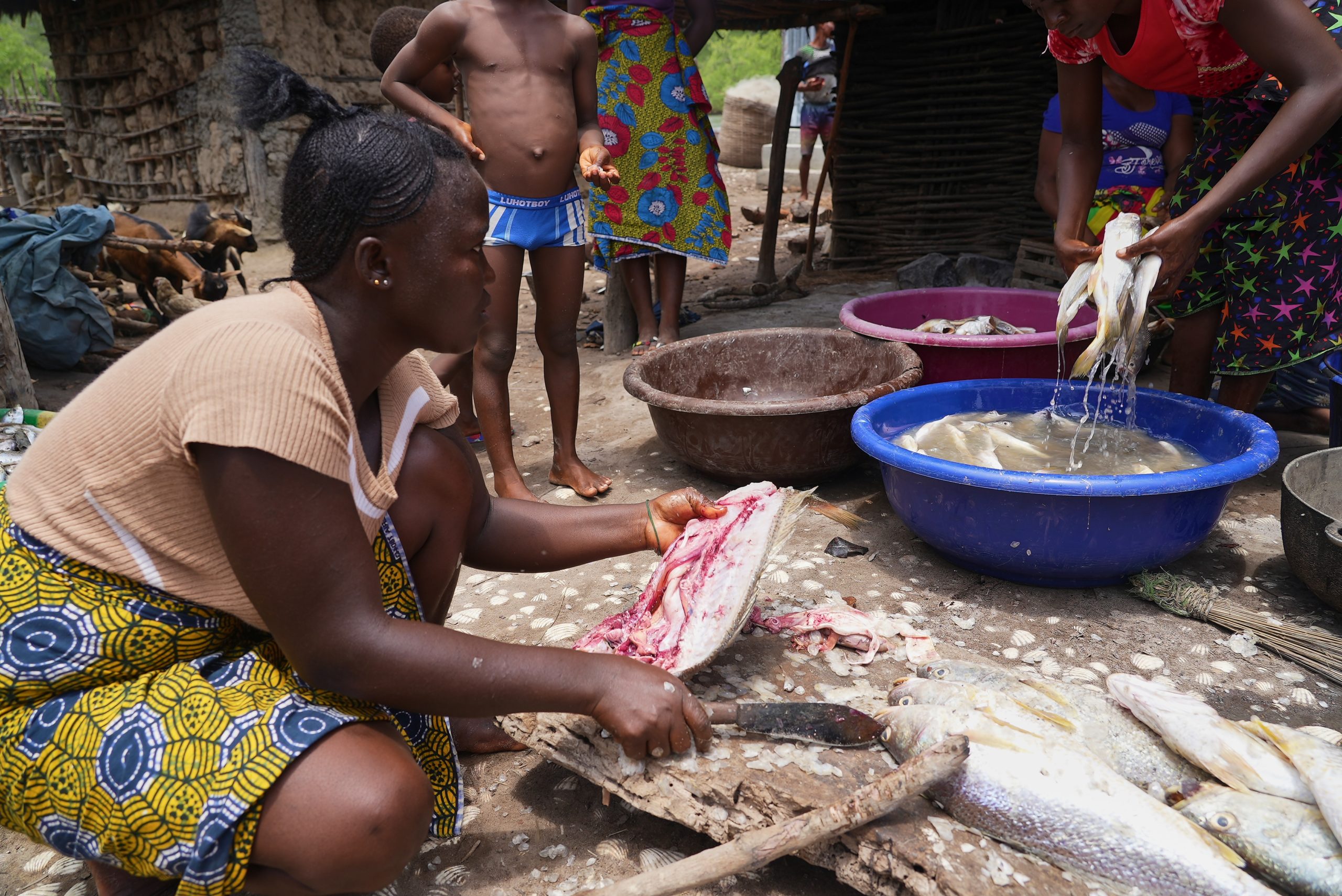 Women in Hanging Site clean fish in preparation for them to be smoked using mangrove wood. Photo by Ashoka Mukpo for Mongabay.
Women in Hanging Site clean fish in preparation for them to be smoked using mangrove wood. Photo by Ashoka Mukpo for Mongabay.
In many respects, the global economy was born in places like Sherbro Island, where the trade in enslaved people gave rise to a commodity boom that fueled the growth of Europe and the United States. Now, the ships of Sierra Leone’s former colonial masters lie rusting on its beaches, slowly being reclaimed by the oceans that carried them there. But the presence of the societies that built them can still be felt in the increasingly urgent lapping of the waves before them, and the angry, unyielding glare of the sun above.
“I’m worried about our present situation, but also extremely worried about the future, especially for our children yet to come,” Bangali told Mongabay. “If during our own time, things have been gotten so much worse like this, so much hotter, and we are manhandling the environment, then the activities of our children will be even more destructive than ours. By the time we pass away, I wonder what is going to be their own fate?”
As I prepared to leave Hanging Site, a young man whom I’d interviewed earlier tapped me on the shoulder. In a soft voice, he said, “I have a question to ask you.” And after a long pause. “Do you know how we can stop the flooding here?”
With COP27 now in the books and the goal of limiting global warming to 1.5°C increasingly looking like a relic of a more hopeful era, the honest answer is: no. But what the world might still be able to do is keep the floods from destroying people’s lives here, and help them protect their environment without deepening their day-to-day struggles. Whether that help arrives, and what shape it takes, will say much about what the future will look like here and in towns like Hanging Site across the world.
Emma Black contributed reporting for this article from Sierra Leone.
Banner image: Daniel Bangali and Miatta Moyu in Hanging Site. Image by Ashoka Mukpo for Mongabay.
Related reading:
In Sumatra, rising seas and sinking land spell hard times for fishers
Adaptation To Climate Change, Biodiversity, Climate Change, Climate Change And Biodiversity, Climate Change And Food, Climate Change And Forests, Climate Change Policy, climate finance, Climate Justice, Coastal Ecosystems, Deforestation, Drivers Of Deforestation, Environmental Politics, Estuaries, Fishing, Flooding, Foreign Aid, Forests, Global Warming, Impact Of Climate Change, Mangroves, Ocean Warming, Oceans, Oceans And Climate Change, Reforestation, Sea Levels
Africa, Sierra Leone, West Africa
Source link : https://news.mongabay.com/2022/12/in-sierra-leones-fishing-villages-a-reality-check-for-climate-aid/
Author :
Publish date : 2022-12-15 08:00:00
Copyright for syndicated content belongs to the linked Source.





